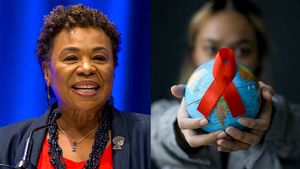In summer 2014, Toronto will host WorldPride, a 10-day celebration that will attract an LGBT crowd from all corners of the globe. The city is anticipating nearly two million people to attend the festivities, a number that is both exciting and challenging for its organizers. But Canada’s largest city is no stranger to crowds. Around one million people attended and participated in this year’s Pride, which included nearly a week of marches, circuit parties, street fairs, drag stars, and musical acts like En Vogue — a dress rehearsal for next year’s extravaganza.
Perhaps one of the most potent symbols of the city’s preparation for WorldPride is the Church Street Mural Project, an artistic endeavor located in the heart of the Church-Wellesley Village, Toronto’s LGBTQ quarter. By October 2013, 13 artists selected by the city will have completed a line-up of 11 large-scale murals inspired by the city’s queer heritage. Lining Church Street, these murals will illustrate Toronto’s diversity through its selection of both local and international artists that have made the city their home.
These artists include John Kuna, a graduate of the Ontario College of Art and Design, who moved from the Czech Republic when he was 10 years old and has established himself as one of Canada’s leading mural artists. The selection also includes Meera Sethi, an Indian-born, Toronto-raised artist whose work explores migration and culture.
The other esteemed artists and studios include Troy Brooks, Public Studio, Alex Flores, Red Dress Productions, Natalie Wood, Nadijah Robertson, Rocky Lawrence Green, Will Craddock, Lily Butterland, and A. Hatanaka & P. Thompson.
These artists are already commencing work to visually transform Toronto’s Gay Village into a veritable rainbow of diversity. But the Church Street Mural Project is only one of the projects planned for WorldPride that are designed to welcome international visitors and inspire community engagement. Other major events include the Arts and Culture Festival, a WorldPride Gala and Awards, a Trans March, a Dyke March, and the WorldPride Human Rights Conference, a three-day human rights conference with a focus on sexual diversity. In addition, WorldPride 2014 will also commemorate the 45th anniversary of the Stonewall Riots in New York City.
It’s a packed schedule. But organizers have been preparing since Toronto’s selection for WorldPride in 2009 — and they’ve been taking notes. Kevin Beaulieu, the Executive Director of Pride Toronto, has studied the organization of the three prior WorldPride festivals in Rome, Jerusalem, and London, as well as Pride celebration across the globe, and determined that communication, both locally and internationally, is key.
“We’ve been developing relationships with the city of Toronto… [and] working with our local community,” said Beaulieu, who helms a seven-person staff at Pride Toronto and anticipates a WorldPride force of 2,000 volunteers. “You need those relationships in place and you need that support so in the 11th hour you’re not scrambling for it. It’s already there for you.”
He points to undertakings like the Mural Project as reminders for the Toronto community that, in less than a year, the city will be lit up by the world’s lavender limilight. Thus, building awareness, Beaulieu contends, is essential to WorldPride’s suceess, as well as “making sure the invitations go out.”
See more renderings on the following pages >>>





















































































